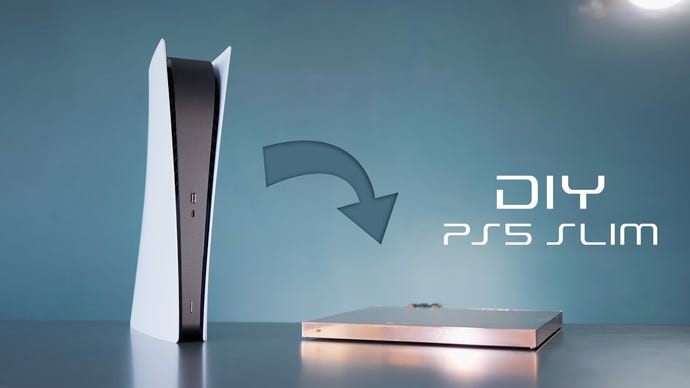DIY PS5 Slim hides a water-cooling brick behind a TV cabinet, almost melts
DIY Perks has managed to reduce the size and operating temperature of the PS5 by a significant amount.
We all know that the PS5 is a huge, unsightly monster. It's massive, it's obnoxious, and it struggles to fit into a lot of people's dedicated living room furniture. A smaller machine – with the same amount of power – is an oft-demanded improvement, at this point. As rumours about a new "genuine professional controller" swirl, one Youtuber has taken it upon himself to see if a PS5 Slim machine is actually realistic.
YouTuber DIY Perks has heard people calling out for a smaller PlayStation 5 console, and has taken the challenge of reducing the size of the newest PlayStation machine to a much smaller footprint - though it comes with some caveats.
After having built the "world's first PlayStation 5 Slim" – in a machine only 2cm tall! – DIY Perks posted a video showing off the process behind shrinking the behemoth console into something a little more... compact.
So why is the machine so small? Well, the Youtuber has taken away all that oversized cooling tech – those vents and fans that make up so much of the PS5's size – in favour of a water-cooling system that's attached to an (out-of-sight) power brick. So it's not the what-you-see-is-what-you-get vibe of modern console design, but hey, at least his 'slim' console is smaller than the OG unit.
The cooling unit – made from Alphacool's 7x40 slim radiators, seven tiny Noctua NF-A4x20 fans for heat dissipation, and an unspecified reservoir/pump combo – is the real star of the show here, and manages to reduce the PS5's operating temperature from 95 degrees Celsius to 52 degrees Celsius (memory temperature). That's a drop of 45%! That's not to be sniffed at, right?
When (and if) Sony builds itself a real, official PS5 Slim, we'll be interested to see if it takes any cues from this wacky experiment. Just be aware that the copper sheets that the Youtuber has used for this shell cost more than the PS5 – and that's just the casing. In terms of practicality and reality, forget this test unit; this video is all for science.



